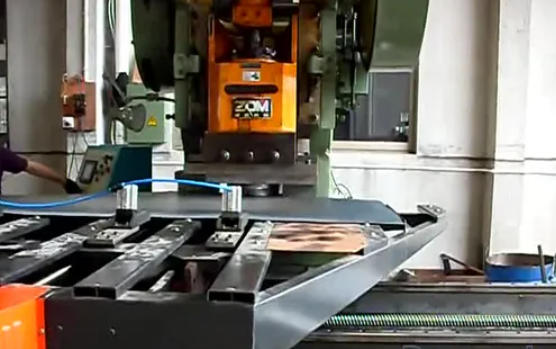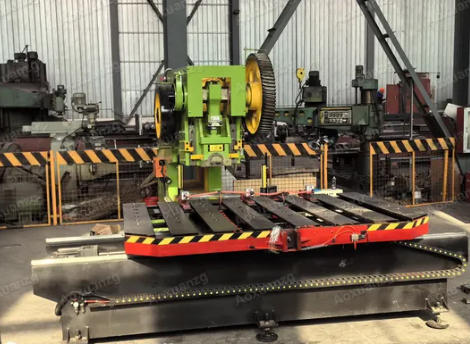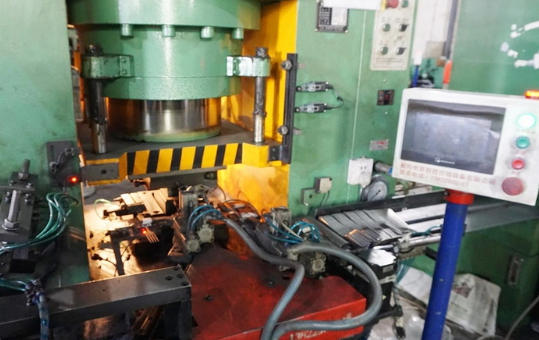Views: 222 Author: Rebecca Publish Time: 2025-11-12 Origin: Site









Content Menu
● The Critical Role of Automatic Feeder Systems
>> Machine Vision and AI-Enabled Quality Control
>> Speed and High-Volume Throughput
>> Modular, Upgradeable Design
>> Advanced Safety and Compliance
>> IIoT and Smart Factory Integration
● Types of Feeder Systems for Cutlery Production
>> Robotic Pick-and-Place Feeders
>> Automatic Polishing and Packaging Feeders
● In-Depth Production Benefits
>> Enhanced Quality and Uniformity
>> Integration with Automation Ecosystem
● Key Selection Considerations
>> Integration and Scalability
>> Service and Maintenance Support
● Technology Trends in Feeder Systems
>> Sustainability and Energy Efficiency
● Case Study: Impact of Feeder Automation in a European Factory
● Workflow: How Automatic Feeders Operate
● Maximizing ROI with the Right Feeder System
● FAQ
>> 1. What is the key benefit of using automatic feeder systems in cutlery production?
>> 2. Can automatic feeder systems handle diverse cutlery types and special materials?
>> 3. How do sensors and machine vision contribute to process quality?
>> 4. What safety features should be present in a modern feeder system?
>> 5. Are automatic feeder systems suitable for small-batch or customized production?
The evolution of manufacturing has brought remarkable changes to cutlery production, with automation playing a pivotal role. Automatic feeder systems stand at the heart of this transformation, eliminating manual bottlenecks, minimizing defects, and enabling factories to achieve new standards of output, safety, and flexibility. This guide delves deeply into all the top features, benefits, design considerations, and technological advances in automatic feeder systems for cutlery manufacturing.

Automatic feeder systems automate the delivery of raw materials and semi-finished components—such as spoons, forks, and knives—into processing machines, including press, trimming, polishing, or packaging stations. By removing manual feeding, they:
- Increase throughput and operational efficiency.
- Standardize the orientation and spacing of components, which improves consistency and reduces the risk of defects.
- Minimize repetitive strain injuries and improve factory safety standards.
As factories grow more complex, adopting automatic feeders becomes essential for handling a broad array of SKUs, meeting tight quality controls, and ensuring cost-competitive operation.
Modern automatic feeders employ advanced controls like servo motors, pneumatics, and logic-based software, bringing significant flexibility:
- Batch programming allows rapid switching between different cutlery types, shapes, sizes, and materials without lengthy downtime.
- Software controls support easy parameter adjustments to accommodate diverse orders, supporting both mass production and customized runs.
- Changeovers, which once required hours of manual work, can now be accomplished within minutes via the user interface or programmatic routines.
Top-tier feeders use machine vision systems, sensors, and AI for real-time inspection, part identification, and rejection:
- Cameras and sensors detect the orientation, deformation, or incompatibility of infeed items.
- Defective or improperly loaded components are instantly diverted, ensuring only high-quality pieces progress.
- Vision systems easily adapt to new product variants without hardware changes, enabling efficient, economic changeovers.
A core benefit of automatic feeder systems is their ability to synchronize high-speed feeding with production lines:
- Industry-grade feeders achieve rates of 28 to over 55 pieces per minute, drastically elevating output.
- Multiple feeder machines can be overseen by a single skilled operator, optimizing labor allocation.
- High-speed delivery ensures presses, polishers, and packagers can all operate non-stop, reducing bottlenecks.
Flexibility is vital as product lines evolve. The most reliable feeders use modular architectures:
- Easily swap feeding mechanisms, tooling, or bowls to handle new part geometries.
- Support for vibratory, robotic, or centrifugal feeding, plus modular sensor and vision upgrades.
- Compact, stackable formats enable integration with existing lines or expansion as production scales.
Safety is non-negotiable in modern cutlery manufacturing environments. Leading feeders incorporate:
- Safety interlocks and emergency stop mechanisms to protect operators.
- Light curtains, door sensors, and non-contact safety devices near moving parts.
- Designs compliant with the latest international manufacturing standards and regulations.
Digitalization transforms feeding into a data-rich process:
- Systems connect to IIoT platforms for real-time status, remote monitoring, and predictive diagnostics.
- Integration with MES/ERP systems for automatic scheduling, traceability, and maintenance planning.
- Feeding equipment can communicate directly with other robotics, presses, and sensors to coordinate workflow across the factory.
These remain an industry mainstay, especially for small parts and variable geometries:
- Use vibrations to orient and advance cutlery parts efficiently.
- Allow high repeatability and minimal adjustment for different product sizes.
- Easily integrate downstream quality control sensors or robotic pickers.
For precise, variable, or delicate geometries:
- Servo drives enable positional accuracy and rapid cycle adaptation.
- Pneumatic or vacuum pick-and-place mechanisms support a vast range of cutlery formats.
- Essential for multi-stage or progressive stamping, trimming, and special shapes.
When maximum flexibility and adaptive feeding are needed:
- 6-axis robots equipped with grippers or suction cups handle an array of part shapes and batch sizes.
- Machine vision systems guide robots for accurate loading and placement.
- Well-suited for short runs, custom products, or mixed-material production lines.
- Specialized feeders support high-speed, consistent delivery of utensils into polishing and finishing equipment.
- Hygienic, programmable, and capable of handling magnetic/non-magnetic stainless steel.
- Automatic packing feeders ensure utensils move directly from production to packaging, improving logistics and minimizing contamination.

Automatic feeders can increase production speeds by up to 35% or more, enabling factories to satisfy greater market demands without additional labor or overtime costs. This scalability is particularly valuable for businesses offering a mix of high-volume and specialty products.
Consistent part positioning ensures every process—stamping, embossing, trimming—yields the same high-quality results, minimizing rejects and increasing customer satisfaction.
Instead of needing several operators per machine, one technician can often oversee multiple feeders, raising efficiency, reducing headcount, and improving ROI.
Sensors, smart diagnostics, and automated jams detection lead to fewer stoppages and less material wasted on defective parts.
Feeder systems act as a backbone for broader automation initiatives. When paired with robotic arms, smart conveyors, and cloud-based analytics, they enable fully digital, lean, and smart factories.
Choose feeders that support your prevalent stainless steel grades (such as 430#, 420#, 410#, 304#, 201#), material thickness (from 0.9mm up to 10mm), and special coatings as required by your production needs.
- Ensure digital compatibility with presses, optics, PLCs, and MES/ERP software.
- Modular, scalable feeders can start small and grow with your factory, reducing upfront CapEx risk.
Some feeder suppliers offer custom tooling and programming services to accommodate unique product shapes or specific process requirements.
- Prefer feeders with easy-to-access parts, clear diagnostic features, and strong technical support.
- Predictive maintenance and quick-troubleshooting guides help minimize costly downtime.
Algorithms can now optimize feeding speeds, learn from line performance, and reduce setup times autonomously, enhancing both productivity and adaptability.
Cloud-linked systems allow real-time remote monitoring, predictive maintenance, and analytics-driven process optimization.
Modern feeders are engineered for lower energy consumption, with some consuming as little as 0.02 kWh per hour, supporting green manufacturing goals and reduced running costs.
For cutlery applications (especially in foodservice), some feeders now support UV sterilization integration and anti-static, easy-to-clean surfaces.
A mid-sized cutlery manufacturer implemented feeder automation across their pressing, trimming, embossing, and polishing stages:
- Output increased by 35%, satisfying increased market demand without extra shifts.
- Labor costs declined by 25%, primarily due to reduced operator requirements.
- Product defects fell by 15%, thanks to consistent part orientation and elimination of human error.
- Notably, workplace safety improved significantly, with no feeding-related injuries in the first operational year.
This case demonstrates the tangible, bottom-line value of investing in advanced feeder systems.
1. Bulk Loading: Stainless steel blanks are poured into large tray hoppers, often holding hundreds of pieces at a time.
2. Material Regulation: Sensors ensure continuous flow and signal for replenishment to keep lines running.
3. Alignment and Separation: Through vibratory, conveyor, or robotic systems, each part is oriented and spaced for the next stage.
4. Precision Placement: Controlled by servo motors or pneumatic actuators, components are positioned exactly for stamping, pressing, or processing.
5. Quality Control: Cameras and sensors conduct real-time inspection, instantly rejecting misaligned or defective parts.
6. Line Synchronization: Feeders match the speed of connected machinery, minimizing jams and stoppages.
To future-proof your factory, create a structured evaluation checklist before purchasing:
- Supported cutlery types/shapes/sizes
- Maximum throughput rate per minute
- Programming and changeover ease
- Maintenance and support infrastructure
- Integration with current and future automation/IT systems
- Energy consumption and space requirements
By balancing these priorities, you'll secure a solution that can adapt to the pace of both business growth and technological advancement.
Automatic feeder systems have become essential to modern cutlery manufacturing. By integrating advanced features—such as programmability, machine vision, modularity, safety, and digital connectivity—manufacturers can optimize production speed, consistency, labor costs, and overall product quality. Investing wisely in these features is instrumental for competitiveness and future-proofing as global manufacturing standards continue to advance. The combination of high-speed, flexible operation and reliable integration with other factory systems secures a smart, adaptable production line ready for today's demands and tomorrow's opportunities.

Automatic feeder systems boost productivity, ensure consistent part quality, reduce human error, and free up labor for higher-value work. This drives both cost savings and improved product outcomes.
Yes. Advanced feeders are programmable and modular, enabling rapid changeover between different products, materials, and custom shapes with minimal downtime.
These systems perform real-time inspections of every item, instantly detecting misfeeds, damaging defects, or orientational errors, and automatically removing any problem pieces to maintain the highest quality standards.
Leading systems include safety interlocks, emergency stops, light curtains, and automatic shutdowns for jams or anomalies, creating a safe working environment and complying with the latest standards.
Absolutely. Programmable controls, modular hardware, and quick changeover capabilities make them well suited for both large-scale and niche production, supporting nearly any manufacturing scenario.
Why The Right Punch Press Machine Is Crucial for High-Quality Tableware Production?
Punch Press Machines: The Backbone of Efficient Cutlery Production
How To Choose Between Manual And Automatic Punch Press Machines?
Best Punch Press Machines for Small And Large-Scale Manufacturers
Top Manufacturers of Punch Press Machines for The Tableware Industry
What Are The Key Benefits of Investing in A Punch Press Machine for Your Factory?
How Punch Press Machines Are Revolutionizing The Cutlery Industry?
The Role of Punch Press Machines in Modern Kitchenware Production Lines
Punch Press Machine Vs. Turret Punch Press: What's The Difference?
